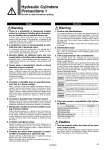
m-03-3c-seihin_en 66 / 77
10秒後にBOOKのページに移動します
Hydraulic Cylinders Precautions 1 Be sure to read this before handling. 1. There is a possibility of dangerous sudden action by cylinders if sliding parts of machinery are twisted due to external forces, etc. In such cases, human injury may occur; e.g., by catching hands or feet get caught in the machinery, or damage to the machinery itself may occur. Therefore, the machine should be designed to prevent such dangers. 2. A protective cover is recommended to minimize the risk of personal injury. If a stationary object and moving parts of a cylinder are in close proximity, personal injury may occur. Design the structure to avoid contact with the human body. 3. Securely tighten all stationary parts and connected parts so that they will not become loose. Especially when a cylinder operates with high frequency or is installed where there is a lot of vibration, ensure that all parts remain secure. 4. Cases when a deceleration circuit or shock absorber may be required. When a driven object is operated at high speed or the load is heavy, a cylinder's cushion will most likely not be sufficient to absorb the impact. Install a deceleration circuit to reduce the speed before cushioning, or install an external shock absorber to relieve the impact. In this case, the rigidity of the machinery should also be examined. 5. Consider a possible drop in operating pressure due to a power outage. When a cylinder is used as a clamping mechanism, there is a danger of work pieces dropping if there is a decrease in clamping force due to a drop in circuit pressure caused by a power outage. Therefore, safety equipment should be installed to prevent human injury or damage to machinery. Suspension mechanisms and lifting devices also require for drop prevention measures. 6. Consider a possible loss of power source. Measures should be taken to protect against human injury and equipment damage in the event that there is a loss of power to equipment controlled by air pressure, electricity, or hydraulics. 7. Design the circuitry to prevent sudden lurching of driven objects. When hydraulic pressure in a cylinder is zero, the driven object will lurch at high speed if pressure is applied to one side of the piston. Therefore, equipment should be selected and circuits designed to prevent sudden lurching because there is a danger of human injury and/or damage to equipment when this occurs. 8. Consider emergency stops. Design the system so that bodily injury and/or damage to machinery and equipment will not occur when machinery is stopped by a manual emergency stop or a safety device triggered by abnormal conditions. 9. Consider the action when operation is restarted after an emergency or abnormal stop. Design machinery so that bodily injury or equipment damage will not occur upon restart of operation. When the cylinder has to be reset at the starting position, install manual safely equipment. 1. Confirm the specifications. The products featured in this catalog are designed strictly for use in industrial oil hydraulic system applications. If the products are used in conditions that are outside the range of pressure and temperature specifications, damage and/or malfunction may occur. Do not use in these conditions. (Refer to the specifications.) Please consult with SMC if a fluid other than hydraulic fluid is to be used. 2. Intermediate stops Since hydraulic cylinders are not guaranteed for zero oil leakage, it may not be possible to hold a stopped position for an extended period of time. 3. Take surge pressure into consideration. Use cylinders which can withstand the surge pressures (maximum allowable pressure) generated in hydraulic systems. (Refer to specifications.) Inside cylinders, pressure may be generated that is higher than the set pressure for the relief valve, e.g., internal pressure due to load inertia or surge pressure when switching valves. Consider these factors and determine the operating pressure so that the pressure generated inside cylinders will be within the maximum allowable pressure. Pressure terminology used in this catalog is defined as follows: 4. Take into account compatibility with hydraulic fluids. Design Selection 1. Use the product within the limits of the maximum usable stroke. The piston rod will be damaged if operated beyond the maximum stroke. Refer to the Hydraulic Cylinder Stroke Selection (Best Pneumatics No. 8) for maximum strokes. Warning Warning Caution Hydraulic fluid Compatibility . Please consult with SMC. Standard mineral hydraulic fluid W/O hydraulic fluid O/W hydraulic fluid Water-Glycol hydraulic fluid Phosphate hydraulic fluid Nominal pressure Maximum allowable pressure Proof pressure Minimum operating pressure Pressure assigned to a cylinder for convenient identification. It is not necessarily the same as the operating pressure which guarantees performance under specified conditions. The maximum allowable value for the pressure that is generated inside cylinders (such as surge pressure). Test pressure that the cylinder must be able to withstand without lowering system performance when returning to the nominal pressure. Minimum pressure at which a horizontally installed cylinder operates with no-load. 61